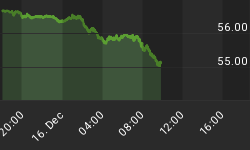Below is an extract from a commentary posted at www.speculative-investor.com on30th January 2005.
Ever since the current system of floating exchange rates came into being in the early 1970s the Swiss Franc has been moving back-and-forth within the confines of the channel depicted on the below chart. So, if we can assume that the pattern of the past 30+ years is going to persist then the Swiss Franc will peak later this decade at around 20% above its December-2004 high and then begin to head back towards the bottom of its long-term channel. The question is: can we reasonably make such an assumption?

We think it's the most reasonable assumption we can make at this time, given the huge amount of uncertainty involved in trying to guess where market prices are going to be several years from now, as long as we also make the assumption that the current monetary system remains in place. Why? Because the reason for the channel's existence is that the people in charge of monetary policy in the developed countries generally want to avoid excessive currency strength AND excessive currency weakness. In particular, after a currency has been trending higher for a few years a point is invariably reached where the currency's strength is perceived, by policy-makers, to be placing an unbearable burden on the country's exporting sector and steps are taken to weaken it. Alternatively, it is likely that drastic action will be taken to strengthen a currency once the currency gets so weak that inflation expectations begin to spiral out of control. In other words, the DESIRE of central banks to avoid having an excessively strong currency combined with the NEED of central banks to prevent their currencies from becoming excessively weak leads to a situation where the major currencies tend not to experience the huge bull and bear trends experienced by some other markets. Instead, the amounts they are able to gain during cyclical bull trends and lose during cyclical bear trends are restricted by the actions of central banks.
The desire of central banks to avoid excessive currency strength, in conjunction with these banks' enormous currency-weakening abilities, is the main reason we think the US$ 'super-bears' -- the people who are forecasting a collapse in the dollar's foreign exchange value -- are going to be wrong. Those who believe that the dollar is going to collapse within the next few years are, we think, only looking at the US side of the equation. In particular, they appear to be drawing the conclusion that the Fed won't be able to prevent a sharp decline in the dollar but failing to account for the actions that would be taken by the ECB et al should such a decline become a high probability. Our view differs, though, because we have no confidence in central banks other than our supreme confidence in their ability to be able to devalue their own currencies.
All of which brings us to our main point: the euro, the Swiss Franc and several other currencies have proven to be very good hedges against US$ weakness over the past few years, but in this regard they are unlikely to be effective in the future. This is because we are rapidly approaching the point where additional currency strength will be deemed excessive. So, even if the dollar hasn't already embarked on a lengthy recovery for non-intervention-related reasons we think its downside, relative to other fiat currencies, will be severely limited by the actions of foreign central banks.
Other than following non-inflationary monetary policies -- something they are always reluctant to do -- central banks can't, however, do much to limit the dollar's downside relative to gold. This is because they can't create gold. They can feed some of their gold reserves onto the market from time to time, but this just shifts existing gold from one place to another and actually has the long-term effect of increasing the gold price by reducing the amount of gold that underpins the monetary system.
The following chart shows how gold has performed relative to the US$ over the same period covered by the above Swiss Franc chart. Note the differences between the two charts; in particular, note that gold IS capable of making huge moves in both directions -- up when confidence in the dollar is falling and down when confidence in the dollar is rising -- and that gold's long-term performance has been vastly superior to that of the Swiss Franc (the US$ gold price has gained about 1140% since the beginning of the 1970s whereas the SF has only gained about 260%).

In conclusion, if you expect that confidence in the dollar will continue to decline over the next few years then you really should accumulate gold and not the non-US$ fiat currencies of the world.
















